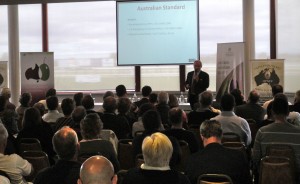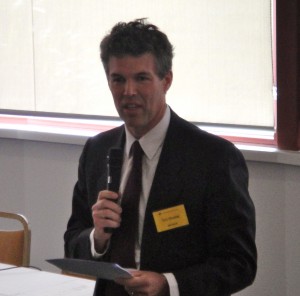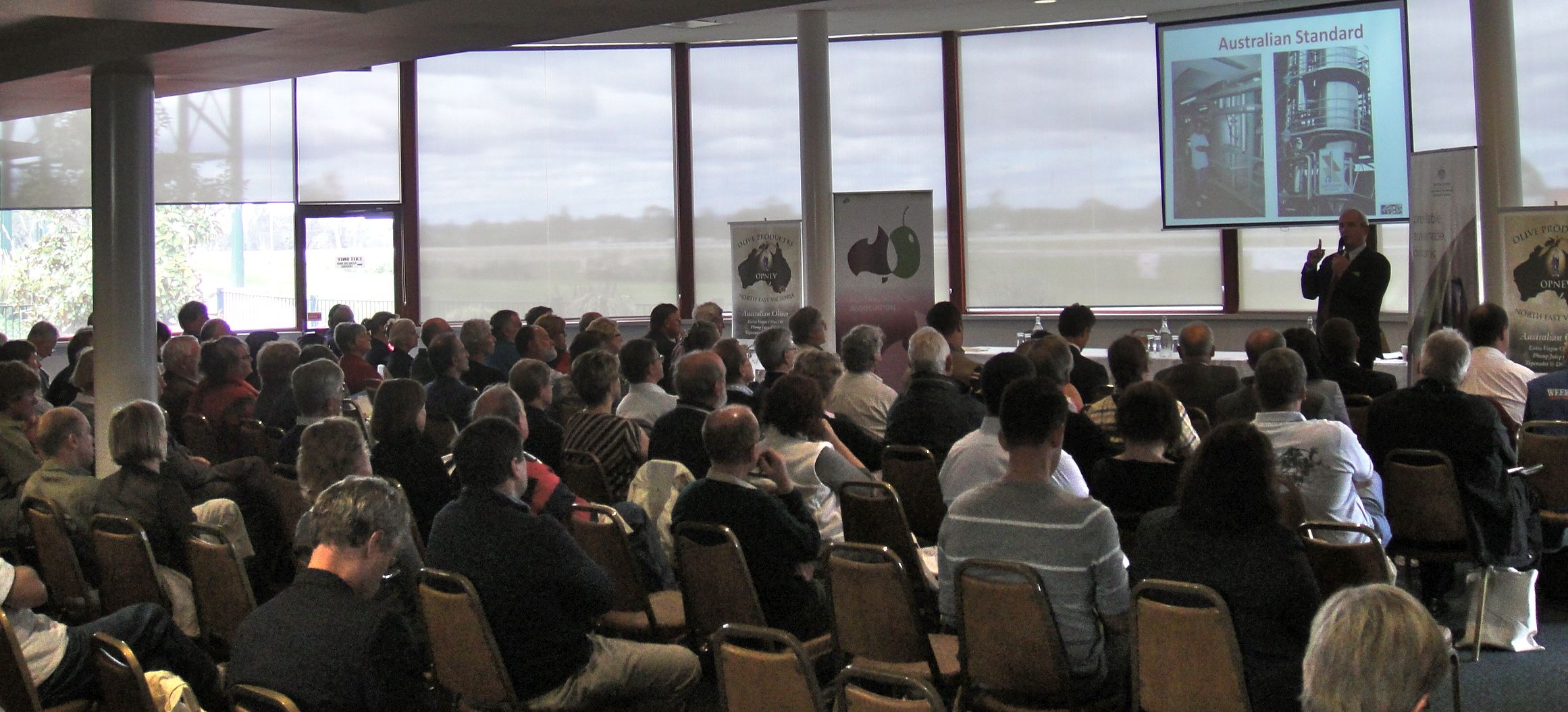Where the Olive Oil Industry is Now, and How We Got Here—
 The theme of the Australian Olive Association’s (AOA) 2011 national conference, “Restoring Trust in the Trade of Olive Oil,” was a logical choice in the year that saw approval of a new olive oil standard in Australia. The adoption of the standard is a big first step to restoring trust, and discussion of it was a hot topic both onstage and off.
The theme of the Australian Olive Association’s (AOA) 2011 national conference, “Restoring Trust in the Trade of Olive Oil,” was a logical choice in the year that saw approval of a new olive oil standard in Australia. The adoption of the standard is a big first step to restoring trust, and discussion of it was a hot topic both onstage and off.
For those who haven’t been following the Australian olive oil standards story, in a nutshell it is a very solidly written standard for olive and olive pomace oils. Many of the important features have to do with clear, truthful labeling. For example, the terms “Light Olive Oil” and “Pure Olive Oil,” which are used to describe a mix of refined olive oil and virgin olive oil, are no longer permitted. Instead, the product must be called what it is: a blend containing refined olive oil. If you make claims of origin or particular processing methods, they must be substantiated. The standard also tightens the screws on what constitutes “extra virgin” by calling for tests that better detect deodorized or old oil. The “best by” date must be backed up with testing to determine shelf life. It is a serious standard, and will go a long way towards cleaning up the trade in substandard, mislabeled and adulterated olive oil in Australia. If you have any doubt of that, check out the reaction from the International Olive Council (IOC). Viewed by many as either a sleeping watchdog or an outright fox guarding the henhouse, the IOC just plain doesn’t like the Aussie standard at all, which makes me think that they are afraid it will do what it is intended to.
Both presentations and panel discussions were dedicated to defining the current situation. Tim Smith of Boundary Bend gave an overview of prices and that shadowy side of olive oil, the traditional import market. As many have observed, the amount of extra virgin olive oil coming out of the major exporting nations is far in excess of what is produced. He also said that 70-75% of it is sold by only six companies.
 Tom Mueller’s investigative journalist’s perspective on Good & Bad Oils – Old & New Worlds was a great glimpse of the world of sinners and saints he has written about in his upcoming book Extra Virginity (due out at the end of November from WW Norton). He gave snippets of stories of outrageous fraud, and obsession with quality, plus funny and bizarre bits of olive oil lore. The book promises be a treat for both the olive oil fanatic who wants to delve deeper into that world, and the novice who seeks a basic understanding of this fascinating food.
Tom Mueller’s investigative journalist’s perspective on Good & Bad Oils – Old & New Worlds was a great glimpse of the world of sinners and saints he has written about in his upcoming book Extra Virginity (due out at the end of November from WW Norton). He gave snippets of stories of outrageous fraud, and obsession with quality, plus funny and bizarre bits of olive oil lore. The book promises be a treat for both the olive oil fanatic who wants to delve deeper into that world, and the novice who seeks a basic understanding of this fascinating food.
Several segments focused on the new standard and olive oil chemistry. Paul Miller described the standard and said that there would be quarterly testing of olive oils from supermarket shelves to determine compliance. He made an observation that underlines how long overdue enforcement of a real standard is: Try buying a bicycle helmet that isn’t made to a strict Australian standard. Paul and Peter O’Clery talked about the Australian Olive Industry Code of Practice as well, a voluntary code that supplements the Australian quality standard. It is a tremendous document, addressing not only the critical items of product quality and safety, but also issues such as traceability, labeling, sustainability and more. A code of practice such as this recognizes that the big picture is essential—not just what you are making, as proven by lab results, but how you make it. For many people, this is part of the trust equation: trust means not just trust in the product, but trust in the company and how it operates.
 Rod Mailer (recently retired from New South Wales Dept of Agriculture but still active in oil chemistry) and Claudia Guillaume (head of the Modern Olives lab) both talked about chemical analysis. Claudia focused on the analytics that can be used to determine olive oil quality and presented the results of an olive oil storage experiment. Rod Mailer talked about the differences between the IOC chemical standard, most of which is targeted at detecting adulteration with seed oils (and functions to limit market access for producers outside the EU through the levels of certain fatty acids) and the new Australian standard. The research confirms that the pyropheophytins (PPP) and the 1,2-diacylglycerol (DAG) tests are good indicators of olive oil age, poor storage conditions, adulteration with deodorized olive oil as well as oil made from deteriorated fruit. It seems pretty clear that the IOC position that the PPP and DAG results are not valid because the “change over time” is nonsensical. That’s the whole point, isn’t it?
Rod Mailer (recently retired from New South Wales Dept of Agriculture but still active in oil chemistry) and Claudia Guillaume (head of the Modern Olives lab) both talked about chemical analysis. Claudia focused on the analytics that can be used to determine olive oil quality and presented the results of an olive oil storage experiment. Rod Mailer talked about the differences between the IOC chemical standard, most of which is targeted at detecting adulteration with seed oils (and functions to limit market access for producers outside the EU through the levels of certain fatty acids) and the new Australian standard. The research confirms that the pyropheophytins (PPP) and the 1,2-diacylglycerol (DAG) tests are good indicators of olive oil age, poor storage conditions, adulteration with deodorized olive oil as well as oil made from deteriorated fruit. It seems pretty clear that the IOC position that the PPP and DAG results are not valid because the “change over time” is nonsensical. That’s the whole point, isn’t it?
A very interesting look at olive oil economics and super-high-density (SHD) orchards was presented by Marek Fisher-Kweicien and Angel Barrio. Marek has a SHD operation in Western Australia that is planted on very marginal soil with poor water and nutrient holding capacity. The climate is extremely hot, and water is precious. He uses pulse irrigation and meticulous monitoring of nutrient and water uptake to ensure that nothing is going to waste. His farming is extremely precise, with the aim of reducing inputs to the absolute minimum. It’s a fascinating case study and is yielding some promising results; this year—his second harvest—he got 3-1/4 tons/acre which yielded 40 gals/ton of evoo. And possibly the most impressive statistic: his high level of automation allows him to farm this 173 acres with only 1-1/2 people. As he puts it, it’s all about keeping costs down.
A note about table olives: Stan Kailis and Peter McFarlane talked about the table olive industry at two separate forums. Great information, and lots of it, but I need to tackle table olives under separate cover another time. Stan and Peter are amazing sources and need more than a cursory footnote!
[Next: AOA National Conference Part II – Where Do We Go From Here?]

Thank you for your observations Alexandra,
It is good to have an independent observer commenting on what what was no doubt the most important meeting about the olive industry that we have ever held in Australia.
We sincerely hope that this was a ‘watershed moment’ – when we finally realised that we and other like minded genuine producer groups need to completely take our destiny in our own hands using evidence, practical research and capitalising on the unshakeable commitment to quality of the vast majority of producers here and in likeminded groups such as the COOC and SA Olive.
It is important during such challenging times to look outwards. The presence at our meeting of Dan Flynn, Andries Rabie, Manuel Parras Rosa, Professor David Hughes, Bruce Golino (by phone) and you was important to provide a broad world context.
I fell that we have ‘done something’ rather than just talked about it.
All the best
Paul
Many thanks, Paul!
This is excellent! Thank you, Alexandra.
” It seems pretty clear that the IOC position that the PPP and DAG results are not valid because the “change over time” is nonsensical. That’s the whole point, isn’t it?”
Yes.
Look forward to reading Part II.
Thanks for that, Selina. That position seems to me a bit like saying that smoke alarms are no good because they will disturb your sleep if there’s a fire!
Great Report Alexandra – great to meet you and looking forward to reading your observations on table olives.
Peter McFarlane
It was good to meet you too, and it will be a pleasure to report on the excellent work you’re doing in table olives, Peter.
Hi Alexandra,
Howzabout some details on the results of the Modern Olives olive oil storage experiment?
I realize this was a drive-by write-up! They looked at storage in clear glass, dark glass and dark plastic at different temperatures. The PPPs were affected more by clear glass and higher temperature storage conditions than the DAGs. In plastic, the PV and K232 showed the impact of oxygen more quickly. Overall, dark glass was the best at protecting the oil. Let me see if I can find a full summary of the experiment and I’ll post a link if I can.
For your readers’ convenience, “AS 5264-2011 Olive oils and olive-pomace oils” is available here…
https://infostore.saiglobal.com/store/Details.aspx?ProductID=1478754
and a the Table of Contents, Scope and Objective are as follows…
CONTENTS
1 SCOPE
2 OBJECTIVE
3 REFERENCED DOCUMENTS
4 DEFINITIONS
5 PRODUCT DESCRIPTION
6 GRADES OF OLIVE AND OLIVE-POMACE OILS
7 GENERIC CHEMICAL COMPOSITION PARAMETERS
8 QUALITY
9 FOOD ADDITIVES
10 CONTAMINANTS
11 HYGIENE
12 PACKAGING
13 METHODS OF ANALYSIS
SCOPE
This Standard applies to all olive oils and olive-pomace oils that are traded in Australia.
This Standard—
(a) defines grades of olive oils and olive-pomace oils;
(b) specifies chemical composition and quality parameters for these grades;
(c) establishes requirements for labelling and packing; and
(d) lists acceptable methods of analysis.
OBJECTIVE
The purpose of this Standard is to provide all those involved in the olive oil and olivepomace
oil trade, from producers to consumers, with a modern reference document which
establishes an objective basis for the trade of these products.
REFERENCES
“AS 5264-2011 Olive oils and olive-pomace oils”also makes reference to other normative publications (also available at http://infostore.saiglobal.com) such as:
AS 6000 Organic and biodynamic products
MP 100 Procedures for certification of organic and biodynamic products
ISO 660 Animal and vegetable fats and oils—Determination of acid value and acidity
ISO 661 Animal and vegetable fats and oils—Preparation of test samples
ISO 662 Animal and vegetable fats and oils—Determination of moisture and volatile matter
content
ISO 663 Animal and vegetable fats and oils—Determination of insoluble impurities content
ISO 3656 Animal and vegetable fats and oils—Determination of ultraviolet absorbance
expressed as specific UV extinction
ISO 3960 Animal and vegetable fats and oils—Determination of peroxide value—
Iodometric (visual) endpoint determination
ISO 5508 Animal and vegetable fats and oils—Analysis by gas chromatography of methyl
esters of fatty acids
ISO 5509 Animal and vegetable fats and oils—Preparation of methyl esters of fatty acids
ISO 8294 Animal and vegetable fats and oils—Determination of copper, iron and nickel
contents—Graphite furnace, atomic absorption method
ISO 9936 Animal and vegetable fats and oils—Determination of tocopherol and tocotrienol
contents by high-performance liquid chromatography
Thank you for that!